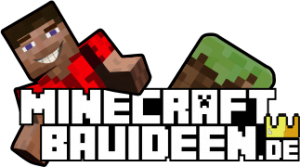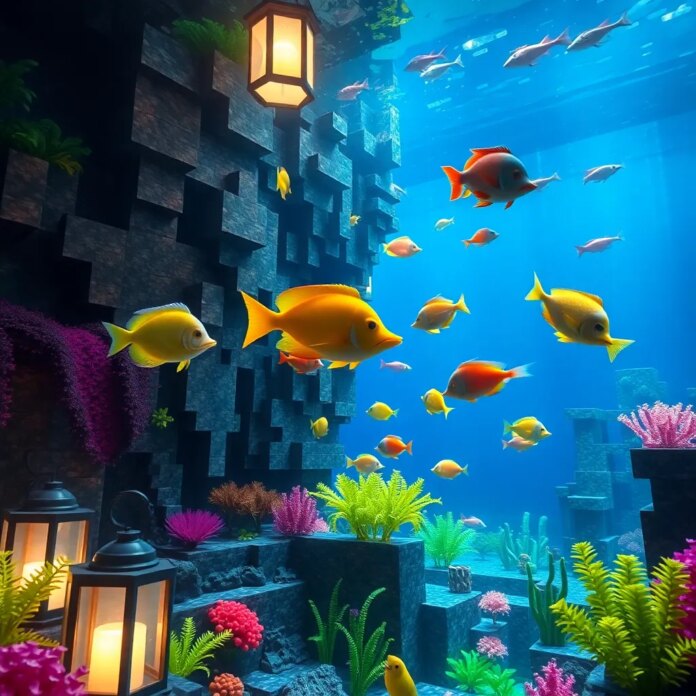Basics of aquarium construction
Building an aquarium in Minecraft starts with carefully choosing the location. A strategically placed location can greatly enhance the aesthetics of your home or base. Popular locations include living rooms, greenhouses or as separate, stand-alone structures next to the main building. When planning, consider the size of the aquarium and the surrounding structures to create a harmonious overall look.
Start with a rectangular or square frame made from blocks of your choice. Materials such as quartz, glass or polished diorite are particularly popular due to their smooth surfaces and modern look. Alternatively, natural materials such as stone bricks or wood can be used to create a more rustic look. The choice of material not only influences the appearance, but also the durability and maintenance requirements of the aquarium.
Glass is best suited for the walls of the aquarium as it provides a clear view of the underwater world. Transparent glass provides an unobstructed view, while tinted glass or colored glass blocks can create interesting lighting effects. Also consider the thickness of the walls to ensure that the water is evenly distributed and the aquarium remains stable.
Water management
Proper water management is crucial for the appearance and functionality of your Minecraft aquarium. Start by filling the aquarium evenly with water. Start in one corner and gradually add water to ensure even distribution. Avoid filling quickly to minimize air bubbles that could disrupt the appearance.
To create a more varied and realistic water landscape, you can incorporate different water depths. Use steps or half-height blocks to create areas with varying depths. These depth variations simulate natural transitions between shallow shore areas and deeper sea zones, which is not only visually appealing, but also makes the habitat more varied for different aquatic creatures.
You can also simulate water currents by installing channels or small bridges within the aquarium. This adds dynamism to the underwater world and ensures that the aquatic inhabitants move more naturally.
Designing an underwater landscape
The design of the seabed is an essential aspect of a realistic aquarium. A varied texture not only provides visual interest, but also offers suitable habitats for different aquatic creatures. Use a mixture of sand, gravel and clay to simulate different bottom textures.
Rocks and stones can be added to create a natural landscape. Different types of stone such as andesite, diorite or prismarine offer a wide range of color and texture variations. Prismarin, for example, gives the aquarium an exotic touch and is ideal for imaginative designs.
Coral reefs are a highlight of any aquarium. Use the different coral blocks and fans that Minecraft offers. Mix dead and living corals to create a natural and dynamic look. Add seagrass, kelp and seaweed to the landscape to bring depth and movement to your underwater world.
You can also add plants and algae to enrich the ecosystem. Different types of plants provide hiding places for fish and contribute to the natural beauty of the aquarium.
Lighting and atmosphere
Lighting plays a crucial role in bringing your aquarium to life. Sea lanterns are an excellent choice as they work underwater and give off a soft, diffused light. Place them strategically to create interesting shadow and light effects that highlight the underwater world.
Glowstone or colored glass blocks can be used for more dramatic effects. These can conceal hidden light sources and create a moody atmosphere. Experiment with different colors and intensities to achieve the perfect underwater mood. Colored lighting can also be used to simulate different times of day or special lighting conditions.
Other lighting options include:
- Luminous stone (Glowstone): Bright, punctual light, ideal for special highlights.
- Redstone lamps: Customizable lighting that can be controlled with Redstone circuits.
- Lamps from Sea Lanterns: Modern design with uniform light.
Also think about the placement of the light sources to achieve a natural light distribution and avoid overlighting, which could distort the colors of the aquatic inhabitants.
Selection and care of aquatic inhabitants
An aquarium is not complete without its aquatic inhabitants. Minecraft offers a variety of aquatic creatures that can populate your aquarium, each with their own special features and care requirements.
Tropical fish: These are particularly popular due to their vibrant colors and patterns. You can choose different types of fish to create a colorful and diverse aquarium. Use water buckets to catch them and transport them safely to your aquarium.
Axolotl: These fascinating amphibians are an excellent addition to any aquarium. They come in a variety of colors and have unique behaviors. Make sure you allow enough space and shallow areas as axolotls will occasionally come out of the water to rest.
Jellyfish: Peaceful jellyfish lend an ethereal quality to your aquarium. Their slow movements and transparent bodies create a calming atmosphere. However, make sure that jellyfish have enough space and are not disturbed by other creatures.
Cuttlefish: These skillful and adaptable creatures require more space and specific conditions. They are ideal for larger aquariums where they can live out their natural behaviors.
To care for the aquatic inhabitants, you should regularly check the water quality and ensure that the light and temperature conditions are optimal. This is less time-consuming in Minecraft than in the real world, but regular maintenance helps to maintain a healthy and vital underwater world.
Care and maintenance
Even though Minecraft aquariums do not require daily maintenance, there are still important aspects that should be considered to keep them in top condition:
1. regular inspection: Check your aquarium regularly for leaks or misplaced water blocks. This will help prevent water leaks and ensure the structural integrity of the aquarium.
2. population control: Make sure that you do not keep too many creatures in a limited space. Overpopulation can lead to performance problems and detract from the experience. Plan appropriately sized aquariums or several smaller tanks.
3. naming: Use name tags for your aquatic inhabitants to prevent them from despawning. This ensures that your aquariums remain permanently populated and the inhabitants do not get lost.
4. feeding and decorative elements: Although it is not necessary to feed fish in Minecraft, decorative elements such as small feeding stations can be added to make the aquarium more lively.
5. cleaning and redesigning: Regularly remove dead plant material or unused decorations to keep the aquarium clean and attractive. This also offers the opportunity to further refine the design and implement new creative ideas.
Advanced techniques
For experienced builders, there are numerous advanced techniques to take aquariums in Minecraft to the next level:
1. infinity edge: Create the impression of an endless aquarium by cleverly combining waterfalls with glass or prismatic blocks. This creates an uninterrupted perspective and adds an impressive visual element to the aquarium.
2. multi-level designs: Build multiple levels into your aquarium to simulate different ecosystems or depths. Each level can accommodate different water conditions and aquatic inhabitants, increasing the diversity and complexity of your aquarium.
3. automated systems: Integrate redstone mechanisms to create moving parts such as water jets or changing lighting effects. Automated filter systems can also be added to simplify the maintenance of the aquarium and make it look more realistic.
4. themed aquariums: Design your aquarium according to a specific theme, such as a sunken ship, an underwater city or a tropical bay. Themes offer a coherent design direction and make your aquarium a real eye-catcher.
5. interactive elements: Add interactive elements, such as doors or archways made of glass that lead to hidden areas. This allows you to create secrets or special zones within your aquarium that can only be discovered on closer inspection.
Integration in construction projects
Aquariums do not have to stand alone. Integrating them into larger construction projects can significantly enhance the overall effect and enable innovative designs:
1. underwater restaurants: build an aquarium around a dining area to create an immersive dining experience. Diners can watch the underwater world as they eat, creating a unique and relaxing atmosphere.
2. aquarium tunnels: Create glass tunnels that run through large aquariums to give the impression of walking underwater. These tunnels offer an exciting way to explore different areas of the aquarium and intensify the experience for visitors.
3. research stations: Combine your aquarium with an underwater research station that serves as a realistic science scenario. This combination is ideal for educational purposes or as a complex detail of your base.
4. public aquariums: Build a large, public aquarium as the centerpiece of a city or amusement park. Such aquariums are impressive structures that attract many visitors and can serve as a central attraction.
5. home decoration: Integrate smaller aquariums into living areas, gardens or other private spaces. These integrated designs add to the natural beauty of your base and provide continuous aesthetic enjoyment.
Challenges and solutions
Various challenges can arise when building aquariums. Here are some common problems and their solutions:
1. water leaks: Water leaks can not only affect the design, but also have a negative impact on surrounding structures. Use invisible light blocks or barriers to stop water in unwanted places. Ensure that all glass blocks are placed correctly and that there are no gaps through which water could escape.
2. mob spawning: Large aquariums can attract enemy mobs due to the increased amount of light. Place sea lanterns strategically to keep light levels high enough to prevent enemy mobs from spawning. Alternatively, you can use additional light sources such as glowstone or redstone lamps to ensure the safety of your aquarium.
3. performance issues: Very large aquariums with many entities and moving parts can lead to performance issues such as lag or low frame rates. Limit the number of aquatic inhabitants and avoid too many decorative elements or redstone circuits. Optimize the size of the aquarium and use efficient builds to improve the performance of your game.
4. realism: It can be a challenge to create realistic underwater landscapes. Experiment with different block and color combinations to create natural transitions and realistic structures. Use differences in height and depth as well as different plant species to increase the variety and realism of your aquarium.
5. space optimization: Large aquariums require a lot of space, which may not always be available. Use vertical construction methods or multi-level designs to make the most of the space available. With creative planning, you can create impressive aquariums even in smaller areas.
Inspiration and community
The Minecraft community is a rich source of inspiration for aquarium designs. Use various resources to gather new ideas and expand your skills:
- Online forums and wikis: Exchange ideas with other players, read tutorials and share your creations in community forums.
- YouTube tutorials: Many Minecraft builders share their projects and techniques on YouTube. These videos offer step-by-step instructions and creative ideas to help you build your aquarium.
- Minecraft servers and building communities: Join building or creative servers to learn from others and work together on large projects.
- Social media and streaming platforms: Share your aquariums on platforms such as Instagram, Twitter or Twitch to get feedback and inspire others.
Don't forget to take screenshots or videos of your finished aquariums. These can not only serve as a memento, but also as a source of inspiration for other players. Share your creations on social media or Minecraft forums to gain recognition and network with other builders.
Conclusion
Minecraft aquariums offer a unique opportunity to combine creativity and attention to detail. From small, decorative tanks to huge, complex underwater worlds, the possibilities are as varied as your imagination. By carefully planning and applying the right techniques, you can create impressive aquariums that are not only aesthetically pleasing, but also provide functional habitats for various aquatic creatures.
With patience and creativity, you can expand and enrich your Minecraft world. Use the wide range of building options, adapt the design to your preferences and be inspired by the community. Immerse yourself in the fascinating world of aquarium building in Minecraft and create underwater worlds that will inspire both you and your fellow players.





